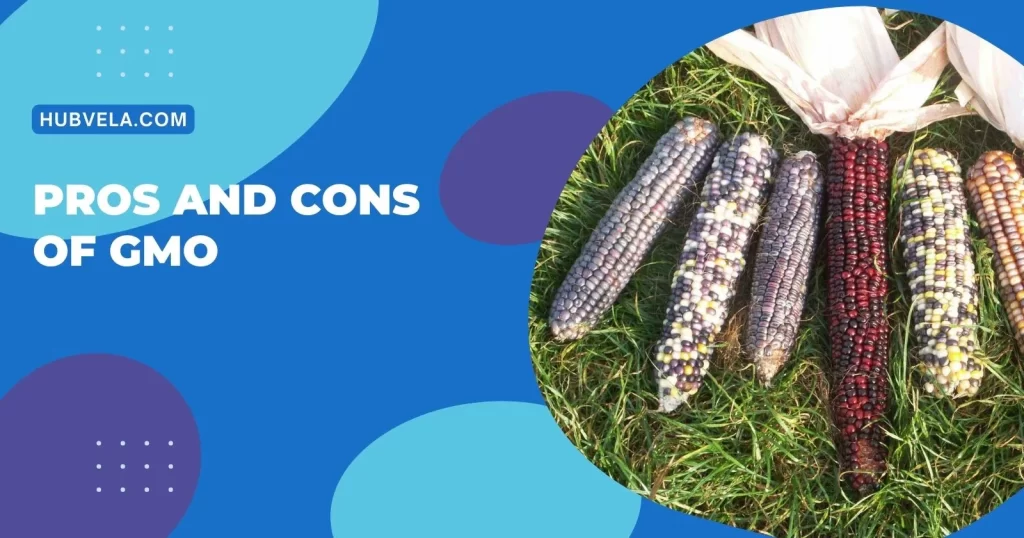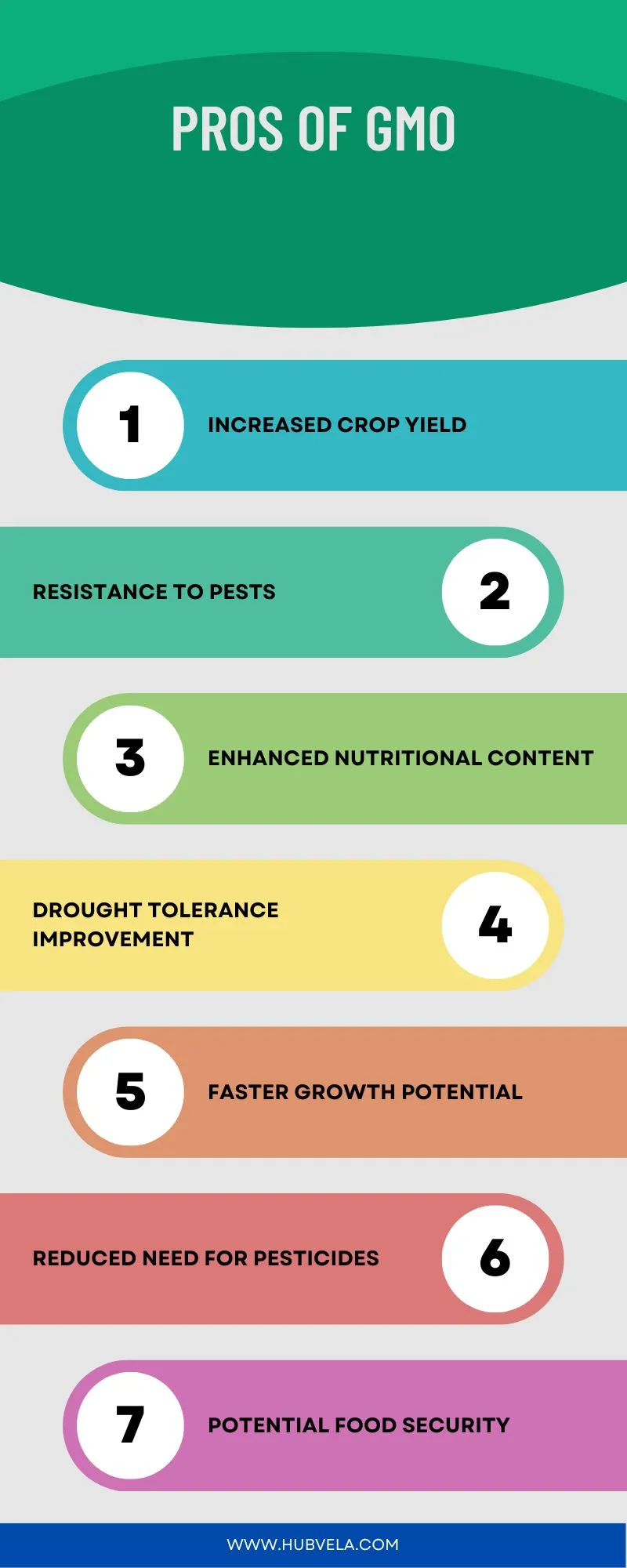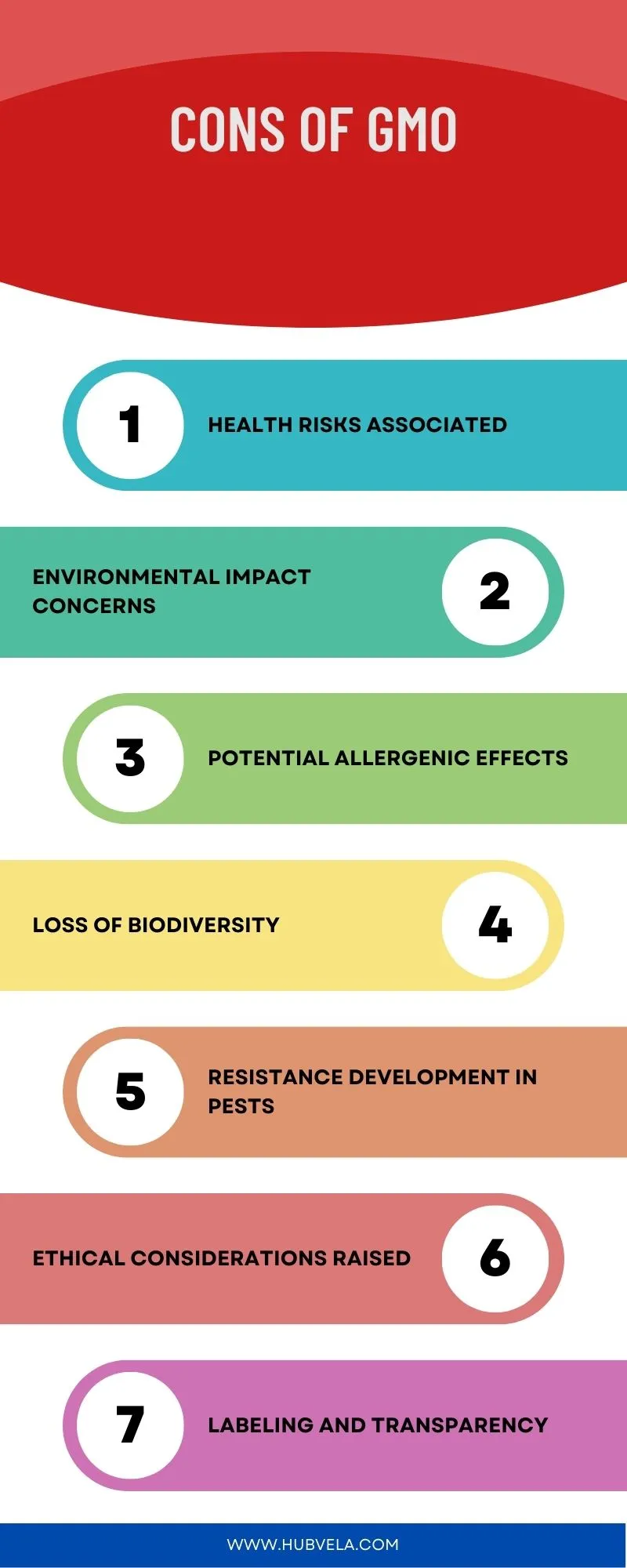Consider the contrasting aspects of GMOs – on one hand, they hold the promise of bolstering food security and meeting the demands of a growing population, yet on the other, they raise concerns about environmental impact and health implications.
As you weigh these pros and cons of gmo, it’s essential to delve deeper into the nuances of genetically modified organisms to make informed decisions.

--Advertisement--
Pros of GMO
In a world where global food security and environmental sustainability are increasingly pressing concerns, genetically modified organisms (GMOs) have emerged as a powerful tool to address these challenges.
As we explore this dynamic field, it is essential to understand the potential benefits that GMO technology brings to agriculture, human health, and our planet’s future.

1. Increased Crop Yield
Genetically modified organisms (GMOs) have been developed to enhance crop yield by introducing specific traits that increase productivity. Through genetic engineering, crops can be modified to be more resistant to diseases, tolerate harsher environmental conditions, and produce higher yields.
This advancement in biotechnology has the potential to address food insecurity by ensuring a more abundant harvest from the same amount of land. By incorporating genes that promote faster growth or increase nutrient absorption, GMOs can significantly boost crop yields.
This means more food can be grown using fewer resources, making agriculture more efficient and sustainable. With increased crop yield, GMOs offer a promising solution to help meet the growing global demand for food.
2. Resistance to Pests
Enhancing crop resilience through genetic modification allows for more effective pest control, increasing agricultural productivity and reducing crop losses. GMO crops can be engineered to produce toxins that are harmful to specific pests, reducing the need for chemical pesticides. This targeted approach helps to protect the crop without harming beneficial insects or the environment.
By incorporating genes from naturally pest-resistant organisms, such as bacteria or other plants, GMO crops can defend themselves against pest attacks more efficiently. This not only benefits farmers by reducing the costs associated with pest control but also contributes to a more sustainable agricultural system.
3. Enhanced Nutritional Content
With the increased focus on improving crop resilience, another significant benefit of GMO crops lies in their ability to enhance the nutritional content of food sources, offering potential health advantages for consumers. Genetic modification allows for the enhancement of essential nutrients, such as vitamins, minerals, and antioxidants, in crops like rice, corn, and soybeans.
For example, golden rice is genetically modified to produce beta-carotene, a precursor of vitamin A, addressing micronutrient deficiencies in regions where rice is a staple food. By fortifying crops with key nutrients, GMO technology has the potential to combat malnutrition and improve overall public health.
These advancements showcase how GMOs can play a vital role in addressing nutritional deficiencies and promoting healthier diets.
4. Drought Tolerance Improvement
Improving crop resilience in the face of water scarcity, GMO technology offers a significant advantage through enhancing drought tolerance in various crops. By introducing genes that help plants conserve water or maintain normal functions during drought conditions, GMOs can contribute to increased agricultural productivity in regions prone to water shortages.
These genetically modified crops have the potential to survive periods of reduced water availability, ensuring a more stable yield even in challenging environmental circumstances. Through the development of drought-tolerant GMO varieties, farmers can mitigate the negative impacts of water scarcity on their harvests, ultimately providing a more reliable food supply.
The ability to withstand drought stress is a valuable trait that GMO technology can impart to crops, making them more resilient in changing climate conditions.
5. Faster Growth Potential
In regions facing water scarcity, GMO technology not only enhances drought tolerance in crops but also accelerates their growth potential, providing a significant advantage for agricultural productivity. By introducing genes that promote faster growth rates, genetically modified crops can reach maturity quicker, allowing for more frequent planting cycles and increased yields.
This faster growth potential can be particularly beneficial in areas with short growing seasons or limited resources, where maximizing productivity is crucial for food security. Rapid growth can help farmers better adapt to changing environmental conditions and market demands, ensuring a more sustainable and efficient agricultural system.
6. Reduced Need for Pesticides
Enhanced pest resistance is a key advantage of genetically modified organisms (GMOs), leading to a reduced need for pesticides in agriculture. GMO crops are engineered to produce toxins that deter pests, reducing the reliance on chemical pesticides. This targeted approach not only protects the crops more effectively but also minimizes the environmental impact of pesticide use.
By decreasing the need for spraying chemical pesticides, GMOs contribute to healthier soil and water systems. Using fewer pesticides can lower production costs for farmers, making agriculture more sustainable in the long run.
7. Potential Food Security
With genetically modified organisms (GMOs), one notable advantage is the potential for enhancing food security through increased crop yield and resistance to environmental stressors. GMOs can help address global food shortages by producing more robust crops that are less vulnerable to pests, diseases, and harsh weather conditions. This increased resilience allows for a more reliable food supply, especially in regions prone to agricultural challenges.
By modifying crops to withstand droughts, floods, or extreme temperatures, GMO technology offers the promise of greater food security for communities facing climate uncertainties. GMOs can be tailored to provide essential nutrients, helping combat malnutrition in populations that lack access to diverse diets.
Cons of GMO
Genetically modified organisms (GMOs) have been a topic of debate for many years. While some argue that GMOs have the potential to solve world hunger and improve crop yields, others are concerned about the potential negative effects on human health and the environment.
We will explore the cons of GMOs. Join us as we delve into the potential drawbacks of genetically modified organisms and the concerns that have been raised by critics of this technology.

1. Health Risks Associated
Consuming genetically modified organisms (GMOs) has been linked to various health risks, raising concerns among consumers and health professionals alike. Some studies suggest that GMOs may trigger allergic reactions in certain individuals due to the introduction of new proteins. There are concerns about the potential development of antibiotic resistance through the use of antibiotic-resistance genes in GMOs.
Another health risk associated with GMO consumption is the possibility of decreased nutritional value in genetically modified crops. Critics argue that genetic modifications could lead to lower levels of essential nutrients in these crops, impacting the overall nutritional content of food products. These health risks underline the importance of thorough research and regulation in the development and consumption of GMOs.
2. Environmental Impact Concerns
Concerns about the environmental impact of genetically modified organisms (GMOs) have been growing in recent years.
One major issue is the potential for GMO crops to cross-pollinate with non-GMO crops, leading to genetic contamination and biodiversity loss. This can have unintended consequences on native plant species and disrupt ecosystems.
The use of GMOs may contribute to the development of pesticide-resistant insects and weeds, leading to an increase in chemical pesticide use. Runoff from fields growing GMO crops can also affect surrounding water sources, impacting aquatic life.
Critics argue that the long-term effects of GMO cultivation on the environment are still not fully understood, raising concerns about sustainability and the overall health of our ecosystems.
3. Potential Allergenic Effects
Genetically modified organisms (GMOs) can potentially trigger allergic reactions in individuals sensitive to specific proteins introduced through genetic modification. This occurs when genes from allergenic organisms are transferred to GMOs, leading to the production of new allergens.
The process of genetic modification may also inadvertently increase the levels of existing allergens in certain crops. The lack of long-term studies on the allergenic potential of GMOs raises concerns about the unknown risks they may pose to human health.
It’s crucial for individuals with allergies to be cautious when consuming GMO products and for regulatory bodies to thoroughly assess the allergenic effects of genetically modified crops before they’re introduced into the market.
4. Loss of Biodiversity
The introduction of genetically modified organisms (GMOs) can contribute to the loss of biodiversity in ecosystems. When GMO crops are introduced, they can outcompete native plant species, leading to a decrease in the variety of plants available in an area.
This reduction in plant diversity can have a cascading effect on other organisms that depend on these plants for food and habitat. The use of GMOs engineered to resist certain pests or herbicides can harm beneficial insects, birds, and other wildlife that rely on these organisms for survival.
This disruption in the natural balance of ecosystems can result in a decline in overall biodiversity, which is essential for the health and resilience of our environment.
5. Resistance Development in Pests
One potential downside of genetically modified organisms is the development of resistance to pests, posing a challenge for sustainable pest management practices. When GMO crops are engineered to produce insecticides, pests can eventually evolve resistance to these toxins. This resistance can lead to the resurgence of pest populations, resulting in increased crop damage and the need for stronger chemical insecticides.
As pests become resistant, farmers may have to resort to alternative control methods, which can be less effective or environmentally damaging. The spread of resistant pests to non-GMO fields can further exacerbate the issue. The continuous cycle of developing new GMO traits to combat resistance can create a costly and unsustainable reliance on genetic modifications for pest control.
6. Ethical Considerations Raised
As you consider the ethical implications of genetically modified organisms, it becomes evident that concerns about the impact on ecosystems and biodiversity are paramount in the debate.
The introduction of GMOs can lead to unintended consequences such as the disruption of natural habitats, the potential loss of native species, and the alteration of entire ecosystems. These changes can have far-reaching effects on the delicate balance of nature, potentially leading to a decrease in biodiversity.
The use of GMOs raises ethical questions about the long-term consequences of manipulating genetic material and the potential for irreversible damage to the environment. It’s essential to carefully weigh these ethical considerations when evaluating the use of genetically modified organisms in agriculture and other industries.
7. Labeling and Transparency
Enhancing consumer awareness through clear labeling and transparency is crucial when discussing the potential downsides of genetically modified organisms. Without proper labeling, consumers may unknowingly purchase GMO products, impacting their health or ethical beliefs.
Lack of transparency in the production and distribution of GMOs can lead to distrust and skepticism among consumers. Labels indicating GMO ingredients can empower individuals to make informed choices about the food they consume, considering their values, health concerns, and environmental impact.
Opponents argue that the absence of mandatory labeling infringes on consumer rights and hinders the ability to make well-informed decisions. Therefore, advocating for transparent labeling practices is essential in addressing the concerns surrounding GMOs and respecting consumer autonomy.
Conclusion on Pros and Cons of GMO
In conclusion, GMOs have their benefits such as increased crop yields and resistance to pests, but also come with drawbacks like potential health risks and environmental concerns.
It’s important to weigh these pros and cons carefully when considering the use of GMOs in agriculture.
Ultimately, the decision to use GMOs should be based on a thorough understanding of the potential benefits and risks associated with their use.


